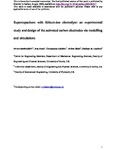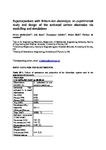Supercapacitors with lithium-ion electrolyte: An experimental study and design of the activated carbon electrodes via modelling and simulations
| dc.contributor.author | Markoulidis, F | |
| dc.contributor.author | Bates, J | |
| dc.contributor.author | Lekakou, C | |
| dc.contributor.author | Slade, R | |
| dc.contributor.author | Laudone, Giuliano Maurizio | |
| dc.date.accessioned | 2020-04-22T08:42:50Z | |
| dc.date.available | 2020-04-22T08:42:50Z | |
| dc.date.issued | 2020-08-30 | |
| dc.identifier.issn | 0008-6223 | |
| dc.identifier.issn | 1873-3891 | |
| dc.identifier.uri | http://hdl.handle.net/10026.1/15589 | |
| dc.description | 12 months embargo applied | |
| dc.description.abstract |
Electrochemical double layer capacitors (EDLCs) are investigated with activated carbon electrodes and a lithium-ion electrolyte, in anticipation of potential future applications in hybridised battery-supercapacitor devices and lithium ion capacitors. An experimental study of a symmetric electrochemical double layer capacitor (EDLC) with activated carbon (AC) electrodes on aluminium foil current collectors and electrolyte 1 M LiPF6 in EC:EMC 50:50 v/v concludes a stability window to a maximum potential of 3 V, an equivalent in series resistance of 48 Ω for 1 cm2 cell area (including the contact resistance between electrode and current collector) and an average specific electrode capacitance of 50.5 F g−1. Three AC electrode materials are assessed via computer simulations based on a continuum ion and charge transport model with volume-averaged equations, considering the pore size distribution for each electrode material and, depending on pore size, transport of tetrahedral solvated or flat solvated Li+ ions and solvated or desolvated PF6− ions. The computer simulations demonstrate that the best electrode material is an AC coating electrode with a hierarchical pore size distribution measured in the range of 0.5–180 nm and bimodal shape, and specific surface area BET = 808 m2 g−1. | |
| dc.format.extent | 422-434 | |
| dc.language | en | |
| dc.language.iso | en | |
| dc.publisher | Elsevier BV | |
| dc.title | Supercapacitors with lithium-ion electrolyte: An experimental study and design of the activated carbon electrodes via modelling and simulations | |
| dc.type | journal-article | |
| dc.type | Journal Article | |
| plymouth.author-url | https://www.webofscience.com/api/gateway?GWVersion=2&SrcApp=PARTNER_APP&SrcAuth=LinksAMR&KeyUT=WOS:000536478700013&DestLinkType=FullRecord&DestApp=ALL_WOS&UsrCustomerID=11bb513d99f797142bcfeffcc58ea008 | |
| plymouth.volume | 164 | |
| plymouth.publication-status | Published | |
| plymouth.journal | Carbon | |
| dc.identifier.doi | 10.1016/j.carbon.2020.04.017 | |
| plymouth.organisational-group | /Plymouth | |
| plymouth.organisational-group | /Plymouth/Faculty of Science and Engineering | |
| plymouth.organisational-group | /Plymouth/Faculty of Science and Engineering/School of Geography, Earth and Environmental Sciences | |
| plymouth.organisational-group | /Plymouth/REF 2021 Researchers by UoA | |
| plymouth.organisational-group | /Plymouth/REF 2021 Researchers by UoA/UoA07 Earth Systems and Environmental Sciences | |
| plymouth.organisational-group | /Plymouth/Users by role | |
| plymouth.organisational-group | /Plymouth/Users by role/Academics | |
| dcterms.dateAccepted | 2020-04-07 | |
| dc.rights.embargodate | 2021-4-11 | |
| dc.identifier.eissn | 1873-3891 | |
| dc.rights.embargoperiod | Not known | |
| rioxxterms.versionofrecord | 10.1016/j.carbon.2020.04.017 | |
| rioxxterms.licenseref.uri | http://www.rioxx.net/licenses/all-rights-reserved | |
| rioxxterms.licenseref.startdate | 2020-08-30 | |
| rioxxterms.type | Journal Article/Review |



